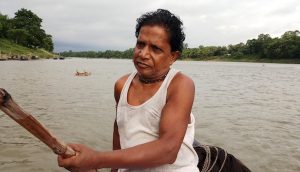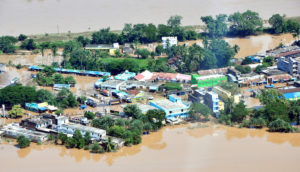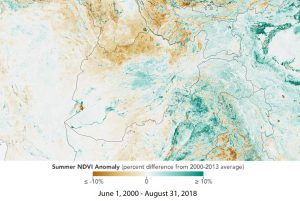The blue bangles make a happy sound as 22-year old Kalnawati pulls down the dupatta on her head to hide her face. Sitting under a tree, she agrees to talk, after her husband Ramesh nods in assent. Once he agrees, so does Indira’s husband, Rajesh.
The green fields dotted with ready-to-pick dundicut red chillies (locally called longi) and the blue sky make a perfect pastoral backdrop for these dozen or so chilli pickers in colourful attire. They are daily wage workers at Kamal Khan Noonwani’s land in the village named after him in Mirwah, in Sindh’s Mirpur district.
The province of Sindh contributes around 85% of red chilli production in Pakistan, the fourth largest producer of red chillies after India, China and Mexico. In fact, the nearby town of Kunri was once known as the ‘chilli capital of Asia’ and still has the country’s biggest chilli bazar of Pakistan.
Nearly 70% of the rural population in Sindh work in the agriculture and livestock sector.
![red chillies on Kamal Khan Noonwani's land [image by: Zofeen T. Ebrahim]](https://dialogue.earth/content/uploads/2018/10/Kamal-Khan-Noonwanis-land-1.jpg)
“The coastal belt where chilli grows best also happens to be at the tail-end of the Nara canal,” he said. The crop requires less water than other crops but more frequent watering – every 15 days.
“But due to the rotational system for distribution of available water in the irrigation system, more popularly known as warabandi, the water did not get to the farmers till the end of the third week, and the plant wilted and died before fruition,” explained Maher.
This is a big loss, as chillies are quite profitable. “A farmer with a 25 acre field can make more profit growing chilli than cotton,” Maher said. Today a 40 kg sack of dried chillies will fetch the farmer PKR 10,000 (USD 75). In comparison a 40 kg sack of cotton will sell for PKR 2,000-3,800 (USD 15-28) depending on the international demand.
Latifa, who grows wheat, cotton, sugarcane and even chillies on her small patch of land, says it is not easy being a small farmer at the tail-end of the canals. “We are never sure if we will be able to get the right amount of water at the right time,” she said exasperatedly.
This year despite perfect weather conditions, chilli production has plummeted because of a lack of water for irrigation.
This has been as massive let down for farmers. There are an estimated 160,000 chilli growers in Kunri alone, according to the Market Development Facility, a multi-country private sector development program funded by the Australian government.
Only 40% of the usual 100,000 acres that is cultivated for chilli every year in Umerkot and Mirpurkas districts was covered this year.
![Indira and Kalnawati in the fields where they start work at dawn [image by: Zofeen T. Ebrahim]](https://dialogue.earth/content/uploads/2018/10/Indira-and-Kalnawati.jpg)
“Our nurseries with chilli seeds were ready but there was no water for three months from March onwards when the seedling is transplanted and it needs regular watering,” Salim said, resignedly.
Salim himself had bought seeds worth PKR 500,000 (USD 4,050) to grow on 40 acres of land (previously he would grow chillies on up to 100 acres) and prepared the nursery too. “But we could not transplant and all my money just went down the drain,” he said. Those who did complained that the fruit wilted and died prematurely, said Salim, who blamed it all on “mismanagement” by the government’s water authorities like SIDA. “There is enough water in the canals for everyone, but only if the more powerful landlords would stop stealing our share!”
Water theft
Latifa, said the more influential farmers somehow, always get “enough water and at the right time.” According to Salim, the Nara canal is supposed to bring in 13,000 cusecs of water to the tail-enders. However, nearly between 2,500 to 3,000 cusecs is used up in the upper stretch, between Sukkur up to Sanghar.
“This is where cotton, sugarcane, rice and wheat (crops requiring frequent irrigation) is grown at the same time when we need water for our chilli crop,” he said adding that the land in the upper region of Narais owned by the “more influential people — including those in the parliament, in the army and the bureaucrats” who use illegal machines to draw and pump water from the canal and its distributaries.
Read: In Sindh water is only for rich and powerful
A physical survey carried out by farmer’s association, of which he is a member, found as many as 650 pumping machines strewn across that part of the canal and to which the water authorities turn a blind eye. “The warabandi does not apply to them and no one dare stop them,” he said.
A SIDA official, on condition of anonymity, acknowledged that it was happening in collusion with the irrigation officers. “Yes there are illegal pumps, not as many as 650, but I would say around 300 installed by the feudals who pay bribes for them to remain there to draw water.”
More than people like Salim, it is the chilli pickers like Indira and Kalnawati who are the worst affected. Less production means less work to be divided among more farm hands. For many households, the male members will migrate to other cities, leaving the women with more responsibilities and more work.
Women play a huge role in bringing the red spice on to our tables.

She blamed TV, Pakistani movies and even school books that stereotyped rural life with male farmers driving tractors, hoeing, spraying pesticides and women only fetching water and bringing food.
In her case, Latifa works at various farms – wheat, cotton and chilli – and is the main bread-earner for her family while the husband works “when he feels like it”.
A 2018 UN report states that agriculture in Pakistan has undergone “feminization” employing nearly 7.2 million rural women becoming the “largest” employer of Pakistani women workers.
Yet their multidimensional work with “lines between work for economic gain and work as extension of household chores (livestock management) and on the family farm… “does not get captured”.
The FAO says the Sindhi rural women in agriculture should be recognized as women farmers not just as sharecroppers or farm hands. Women in rural Sindh work, on average, between 12 to 14 hours a day. They represent 48% of total labour input for winter crops and 49% for summer crops, yet only 5% own land.
A village woman’s work is never done
Every day since the chilli season began, Indira and Kalnawati have been picking the chillies since dawn and stop around 1:00 pm in the afternoon.
![While men like Rajesh labour in the fields, their work ends when they head home, unlike that of the women [image by: Zofeen T. Ebrahim]](https://dialogue.earth/content/uploads/2018/10/Rajesh-2.jpg)
But the men’s work ends there. Once home, they rest before going off to meet other men and catch up on the affairs of the world. For women it is back to the grind and to carry out the left over chores. “We head back to the field to cut grass for the livestock,” said Indira. By the time this work gets done, it’s almost sundown, she says.
“Once I get home, I rest and wash up, before heating up the cooked food and making fresh bread for the family,” she continued.
If she has one wish, Indira whispers so her husband cannot hear, it is to “sleep in just a little while longer and not head for the farm for just one day”. But she dare not since her daily wages help bring the rations for the next day’s meal.
Support for this story was provided through a fellowship under the DFID-funded Informing Change in the Indus Basin Project led by the International Water Management Institute. The views expressed are solely those of the author and in no way reflect those of IWMI or DFID
![<p>Women make up much of the labour force on chilli farms in Pakistan [image by: Zofeen T. Ebrahim]</p>](https://dialogue.earth/content/uploads/2018/10/IMG_3660.jpg)





![The Indus at the site of the proposed Diamer-Basha dam [image by: Water and Power Development Authority, Pakistan]](https://dialogue.earth/content/uploads/2017/05/Indus_Diamer_Basha_Dam_Site_Image_WAPDA-300x169.jpg)


